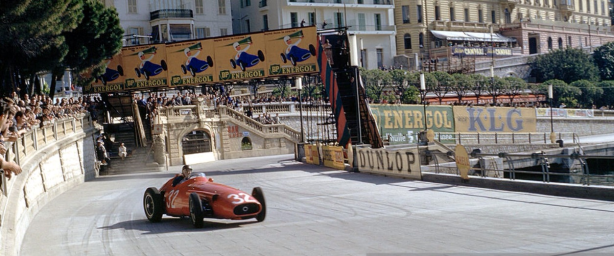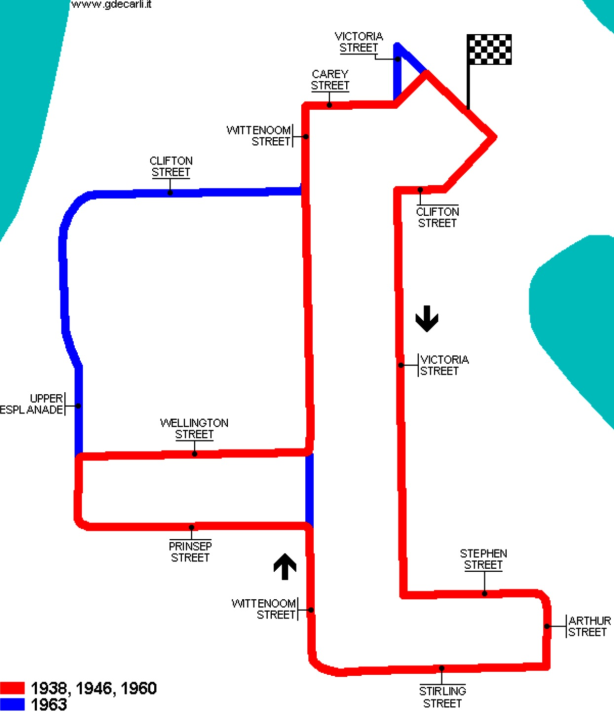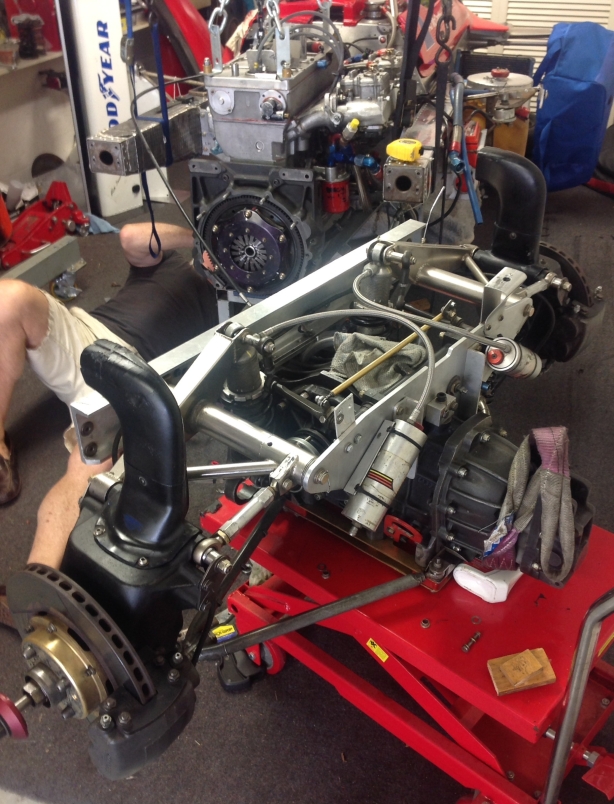Juan Manuel Fangio eases his Maserati 250F through Tatts Corner, Aintree, Liverpool during the 1957 British Grand Prix on 20 July…
Fangio qualified 4th but retired on lap 49 with engine problems, its an amazing shot ‘the maestro’ looks so relaxed at the wheel. Its the cover shot of a book i have, much of my library is in storage, a real pain in the arse in terms of access to research material, maybe one of you have the same book and can recall the title?
The race itself was a Vanwall benefit; Moss lead then took over Brooks car when his own engine went off song, Stewart Lewis-Evans Vanwall also lead briefly before being passed by Moss, he and Brooks shared the win from the Lancia Ferrari 801’s (LF801) of Luigi Musso and Mike Hawthorn.
This article is pieced together around a swag of photos of Fangio aboard Maserati 250F’s in 1957, in many ways the combination defines the 1950’s for me. The greatest driver of the decade in its quintessential car, it may not have been the fastest of the era but for sure it provided a platform for so many drivers from journeymen (and women) to gods, to strut their stuff.
Monaco, 19 May 1957…
Between Moss who left Masers to join Vanwall and Fangio who left Ferrari to join Maserati the seven 1957 championship rounds, ignoring Indianapolis, were mopped up by those two drivers- Juan with 4 wins and Stirling 3.
Fangio made the 250F sing, the car was towards the end of its long competitive life with the great Argentinian extracting all it had to offer. He was at the height of his powers, I don’t doubt he retired at the right time, he was 46 years of age by the end of the season after all.
Having said that it would have been fascinating to see if he could adapt to mid-engined cars, I don’t doubt he would have had he raced on for a few more years. But best to retire at the top, and alive. So many elite sportsmen and women do that one season too many, Michael Schumacher for one, Fangio did not.

# Carlos Menditeguy DNF spin and #34 Giorgio Scarlatti DNF oil leak in the Officine Maserati garage, Monaco 1957. 250F x 2
Fangio popped his 250F on pole in the Principality but Moss led into the first corner with Fangio behind him. Sterling went off and crashed at the chicane on lap 4 with Collins, LF801, taking exasive action and hitting a stone wall as a result! Fangio managed to get through without a problem and Brooks Vanwall braked hard only to be rammed up the chuff by Hawthorn’s Fazz.
Only Brooks was able to keep going- but he was 5 seconds behind Fangio by the time he was up to speed again. Jack Brabham was up to 3rd late in the race in his little Cooper T43 Climax. It was a portent of the 1958 breakthrough win for a mid-engined car by Moss in Argentina, but had to push the car home as result of fuel pump failure, Jack was classified 6th, with Fangio ahead of Brooks, Masten Gregory in a Maserati, Lewis-Evans Vanwall and Trintignant LF801.

Fangio during Monaco practice in Giulio Alfieri’s 250F V12. The 60 degree, DOHC, 2 valve, 24 plug, Weber fed 2.5 litre engine developed circa 300-320bhp at a dizzy 10500rpm, about 50bhp more than the venerable inline 6 but the power was all at the top of the band. The engine had conrod and valve spring troubles early in its development too. Behra raced one in the Italian GP, he chomped thru tyres, such was the engines power and then retired with a lubrication problem. The engines time would come, but not for a decade!
Whilst the 250F was in the Autumn of its life Maserati were still developing the thing, not least with a 2.5 litre, quad-cam, 2 valve, Weber carbed 300 odd bhp V12. Fangio is putting some development laps into the thing at Monaco above.
The engine raced only once at championship level at Monza 1957, but suitably evolved in 3 litre, fuel injected form won a race or two mounted in the back of Cooper’s T81 and T86 in 1966/7. (Wins for Surtees ’66 Mexican GP and Rodriguez ’67 South African GP, both in T81’s)
An interesting Australian sidebar to this Maser V12 is Frank Gardner and Kevin Bartlett testing a 2.5 litre variant in the butt of a ‘cut and shut’ Tasman Brabham BT11A in February 1966. Sydney Alfa/Maserati dealer and former Australian 1960 Gold Star Champion and AGP winner Alec Mildren used his impeccable Maserati connections to score the engine which the team sussed as an alternative to the venerable Coventry Climax 2.5 litre FPF which was the Tasman staple moteur at the time. Simply put the engine was like an on/off switch in terms of its power delivery, then blew, which rather settled the matter of a ‘Warwick Farm 100’ start. A story for another time.

Fangio, quayside at Monaco in 1957, enroute to victory. He won in Argentina, Monaco, France and Germany. The Vanwalls won in Britain, Pescara and again in Italy at Monza; Moss/Brooks, Moss and Moss
The thing that always amazes me when looking at photos of Fangio is just how relaxed at the wheel he is. It’s key to great lap times, if you are that tense that your butt-cheeks grab the seat cover as you alight your racer you are definitely not going to feel what your steed is doing to extract the best from it! I remember Frank Gardner talking to me about this very point several decades ago.
When the laconic Aussie all-rounder returned home in 1975, in that first year he drove Bob Jane’s Holden Torana Chev Sports Sedan and fronted the Jane/Gardner Racing Drivers School at Calder. He wasn’t there much. In fact ex-Aussie F3 driver/mechanic and later Hardman F2 designer/builder Jim Hardman did most of the driver instruction aided by Andrew Newton, who also raced with some success. Both of them looked after the fleet of Elfin 620B Formula Fords driven by the bright eyed hopefuls, of whom i was one.
Anyway, on this particular frigid July day ‘ole FG was in effusive mode telling me about both the car setup advice and driver coaching he was giving to a well known fellow who had not long before jumped up from Formula Ford to F5000-105bhp to 500bhp is a big step.
His central point in talking about ‘the big car challenge’ was all about relaxing in the car- having soft hands and gentle feet and just being able to, as a consequence of not being so tense, feel what the car was doing and therefore be able to push the thing to its limits by better sensing said limits when reached…Easy to say of course, harder to do especially when you have 500bhp of fuel injected Repco-Holden V8 shoving you ferociously towards the horizon!

FG would have approved of Fangio’s relaxed demeanour in a car. Don’t confuse my meaning with the ferocious competititiveness and delicacy of control that went with the outer calm one can see here!
Fangio never looks anxious whether he is being closely followed at Monaco in third gear or drifting through the very high speed swoops of rural France at over 140mph in fifth.
It was magic to observe Fangio’s car control at close quarters when he was 67 years old and booting his W196 Benz sideways lap after lap in third gear through Sandown Park’s Shell Corner, only 30 metres away, during ‘The Fangio Meeting’ in 1978. The sight of this grand man of racing flicking the bellowing, powerful straight-8, silver beastie around is forever etched in my memory.
Cool, calm, collected, composed and FAST! Exactly as he was in 1957…
French GP, 7 July 1957…
The classic was held at the super fast Rouen-Les-Essarts road circuit in Grand-Couronne and Orival, northern France.
There are so many wonderful 250F shots of Fangio in 1957 drifting the sublimely forgiving chassis at well over 140 mph on public roads through wooded hillsides. I’m not suggesting, in describing the car as forgiving, it was easy my friends!

Crusin’ in having set pole i wonder? Rouen 1957. The lines of the 250F in 1957, here it’s Fangio’s ‘regular ‘Long nosed, lightweight’ chassis ‘2529’ spec are perfect, inch by sculpted inch. The cars epitomise everything great about Italian racing machines. Alfieri’s ’57 lightweight chassis was 40% stiffer than in ’56 with greater rear weight bias-48/52% front/rear. The 250F was maybe not quite the fastest tool in the 1950’s shed but it was close to it, enduring and capable of winning the 1954 and 1956 titles in addition to ’57 with more luck or the right bloke behind the wheel all season! No-one was going to beat Fangio in a W196 Merc in 1955 i don’t think
Fangio was fastest from Behra and Musso also on the front row. Behind them were Schell 250F and Collins then back a row Salvadori, Vanwall VW57 Hawthorn and Trintignant. At the jump Behra lead but Musso soon got ahead. Fangio was 3rd then Collins and Schell giving chase and then a fast-starting McKay-Fraser, BRM P25. Fangio worked his way past Behra on lap 2 and then took Musso for the lead on lap 4.
Collins got past Behra and the order remained unchanged at the front all the way to the flag with Fangio winning from Musso and Collins. Behra slipped behind Hawthorn, giving the Lancia-Ferrari 801 a 2-3-4 finish behind Fangio.

Hang on…Fangio indulging in one of his signature, oh so fast, oh so subtle and oh so wonderful, delicate, four wheel drifts. Poetry in motion innit!? Wonder who or what he tapped?
Germany, Nurburgring, 4 August 1957: Greatest GP of all?…
Fangio’s heroic drive at this most demanding of circuits proved to be his greatest ever drive and one of the best in the history of Grand Prix racing.
Fangio took pole with Hawthorn, LF801 Behra, 250F and Collins LF801 completing the front row. Then came Brooks, Schell and Moss on Vanwall VW57, 250F and Vanwall VW57. At the start Hawthorn and Collins battled for the lead with Fangio and Behra giving chase. On lap 3 Fangio passed Collins and soon led. Collins then passed Hawthorn and chased after Fangio with the great man edging gradually away.

Nurburgring 1957: Hawthorn and Collins, L Ferrari 801, Fangio and Behra 250F, then Moss and Brooks Vanwall VW57, Masten Gregory’s white Maser 250F, Lewis-Evans Vanwall VW57 and the rest…
A slow mid-race pit stop, scheduled for 30 seconds, lasted 1 minute and 18 seconds. One of the mechanics dropped the wheel hub nut under the car, it couldn’t easily be found! This left Fangio a minute behind the two Ferraris but then the chase was on! He drove absolutely at the limit, at the ragged edge of the cars capabilities, chasing down the two much younger men.
Fangio famously broke the lap record 10 times and passed both Collins, and then Hawthorn on the penultimate lap. Fangio won the race and in the process, his 5th and final World Title in a drive still spoken about in reverential terms and forever remembered whenever the great GP races are considered.
Pescara GP, 16 August, The Coppa Acerbo…
The FIA included the Coppa Acerbo, Pescara GP in the World Championship for the first time given the cancellation of the Dutch and Belgian GP’s early in the season due to squabbles about money. The daunting, dangerous 16-mile road circuit on the Adriatic Coast, still used then for non-championship events was the longest ever for an F1 race.
Ferrari didn’t bother to send 801’s for Mike Hawthorn and Peter Collins as the World Championship had already been won by Fangio and partly as a protest against Italian government’s move to ban road racing following Alfonso de Portago’s, Ferrari 335S Mille Miglia accident earlier in the year. Local boy Luigi Musso convinced Ferrari to lend him a car however, which he entered as a privateer. Shades of NART entries in the 1960’s when Ferrari wanted to protest, but not too much!

Shot at left shows Fangio’s Maser having a rear wheel replaced after spinning on Musso’s engine oil and danaging it
The Pescara battle was between Maserati and Vanwall and resulted in a Maserati pole for Juan-Manuel from Moss’s Vanwall VW57 and Musso’s ‘private’ Ferrari 801.
Musso took the lead but Maserati 250F privateer Horace Gould hit a mechanic who was slow to get off the grid. Brooks retired his Vanwall VW57 early with mechanical troubles. Moss took the lead from Musso on lap 2 from Fangio in 3rd but the field thinned as the heat took its toll; Lewis-Evans, Vanwall with tyre failures, Behra 250F engine failure. Then Musso disappeared on lap 10 when his engine blew, the oil caused Fangio to spin and damage a wheel. When Fangio rejoined, Moss had an unassailable lead, he won the race ahead of Fangio, Schell in 3rd ,Gregory 4th and Lewis-Evans 5th.
Fangio won the World Championship on 40 points from Moss and Musso on 25 and 16 points respectively. Maserati 250F, Vanwall VW57 and Lancia Ferrari 801.
Credits…
All photos by Louis Klemantaski/Getty Images, Michael Turner
Tailpiece: The Maestro, Karussell, Nurburgring, Maser 250F chassis ‘2529’ German Grand Prix 1957, history being made. Majestic shot…














































